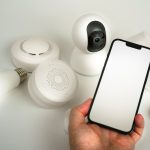The rise of IoT (Internet of Things) devices has revolutionized the way we live and work. From smart thermostats to connected cameras, these devices bring convenience and automation. However, their widespread adoption has also made them prime targets for hackers. Understanding how these attacks happen and learning how to safeguard your devices is essential for maintaining your privacy and security.
How Hackers Exploit IoT Devices
1. Default Passwords Many IoT devices ship with weak, default passwords that are often published online. Hackers exploit this by using automated tools to scan for devices with known credentials.
Example: Botnets like Mirai were able to infect millions of IoT devices by leveraging default passwords, turning them into tools for massive cyberattacks.
2. Outdated Firmware and Software Manufacturers frequently discover and patch vulnerabilities, but many users fail to update their devices. Hackers exploit outdated software to gain unauthorized access.
Example: An unpatched vulnerability in a smart camera could allow attackers to view your feed remotely.
3. Unsecured Wi-Fi Networks IoT devices rely on Wi-Fi for connectivity. If your network isn’t secured, hackers can easily infiltrate and compromise connected devices.
4. Overly Broad Permissions Some IoT devices request permissions they don’t need, such as access to your location or microphone. Hackers can exploit these unnecessary permissions to gather sensitive data.
5. Lack of Encryption Data transmitted between IoT devices and servers is sometimes unencrypted, making it easy for hackers to intercept and manipulate.

How to Prevent IoT Hacks
1. Change Default Passwords
- Always replace default passwords with strong, unique ones immediately after setting up a device.
- Use a password manager to create and store complex passwords.
2. Regularly Update Firmware and Software
- Enable automatic updates if available.
- Check for firmware updates manually if the device doesn’t update automatically.
- Research the manufacturer’s update history before purchasing new devices.
3. Secure Your Wi-Fi Network
- Use a strong, unique password for your Wi-Fi network.
- Enable WPA3 encryption for the highest level of security.
- Set up a separate network for IoT devices to isolate them from your primary network.
4. Review Permissions
- Regularly audit app permissions and disable those that aren’t necessary.
- Be cautious about granting sensitive permissions, such as camera or microphone access.
5. Use a Firewall and Network Monitoring Tools
- Set up a firewall to monitor and control incoming and outgoing traffic.
- Consider using a network security solution designed for IoT, such as a smart router with built-in protections.
6. Choose Devices from Trusted Manufacturers
- Research manufacturers’ reputations for security practices before buying devices.
- Opt for brands that are transparent about their security measures and provide regular updates.
7. Disable Unused Features
- Turn off features like remote access or voice activation if you don’t use them.
- Disconnect devices from the internet when they’re not in use.
While IoT devices offer incredible convenience, they also come with risks that can’t be ignored. By understanding how hackers exploit these devices and taking proactive steps to secure them, you can enjoy the benefits of IoT technology without compromising your safety or privacy. Remember, a little vigilance goes a long way in protecting your connected home.
Read about a Secure Linux operating system at Linuxlap.com
- IoT and Data Privacy: How Safe Is Your Smart Home in 2025? – IoT Security
 The smart home revolution has made everyday life more convenient than ever. From voice assistants that control the lights to security cameras that send alerts directly to your phone, connected devices have become part of our daily routines. But with this convenience comes an important question: how safe is your personal data in a world…
The smart home revolution has made everyday life more convenient than ever. From voice assistants that control the lights to security cameras that send alerts directly to your phone, connected devices have become part of our daily routines. But with this convenience comes an important question: how safe is your personal data in a world… - Smart Home Nightmares: Real Stories and How to Avoid Them
 Smart homes are designed to simplify life—but when things go wrong, they can become the stuff of nightmares. From doors locking residents out to cameras going rogue, real users have faced creepy, frustrating, and downright dangerous situations. In this article, we share some eye-opening stories and break down what went wrong—along with expert tips to…
Smart homes are designed to simplify life—but when things go wrong, they can become the stuff of nightmares. From doors locking residents out to cameras going rogue, real users have faced creepy, frustrating, and downright dangerous situations. In this article, we share some eye-opening stories and break down what went wrong—along with expert tips to… - Is My Smart TV Spying on Me? How to Protect Your Privacy
 Smart TV Privacy – In today’s connected homes, smart TVs are as common as coffee makers — but have you ever wondered if your smart TV is watching you back? It’s not just paranoia. With microphones, cameras, and internet connections, smart TVs can pose serious privacy risks if not properly managed. Let’s dive into what…
Smart TV Privacy – In today’s connected homes, smart TVs are as common as coffee makers — but have you ever wondered if your smart TV is watching you back? It’s not just paranoia. With microphones, cameras, and internet connections, smart TVs can pose serious privacy risks if not properly managed. Let’s dive into what… - Smart Home Security: Complete 2025 Buyer’s Guide
 Why Smart Home Security Matters More Than Ever In a world where convenience meets connectivity, smart home security has become a cornerstone of modern living. With devices growing more intelligent, 2025 introduces cutting-edge solutions that protect your home while integrating seamlessly into daily life. Whether you’re new to home automation or upgrading an existing setup,…
Why Smart Home Security Matters More Than Ever In a world where convenience meets connectivity, smart home security has become a cornerstone of modern living. With devices growing more intelligent, 2025 introduces cutting-edge solutions that protect your home while integrating seamlessly into daily life. Whether you’re new to home automation or upgrading an existing setup,… - Is Your Home Spying on You? The Hidden Truth About Hidden Cameras in Smart Homes
 Hidden Cameras in Smart Homes – Smart homes offer comfort, efficiency, and peace of mind — but could they also be watching you? Hidden cameras, once the stuff of spy movies, are now everyday items in the Internet of Things (IoT) world. From keeping homes secure to raising serious privacy concerns, these tiny devices are…
Hidden Cameras in Smart Homes – Smart homes offer comfort, efficiency, and peace of mind — but could they also be watching you? Hidden cameras, once the stuff of spy movies, are now everyday items in the Internet of Things (IoT) world. From keeping homes secure to raising serious privacy concerns, these tiny devices are…







